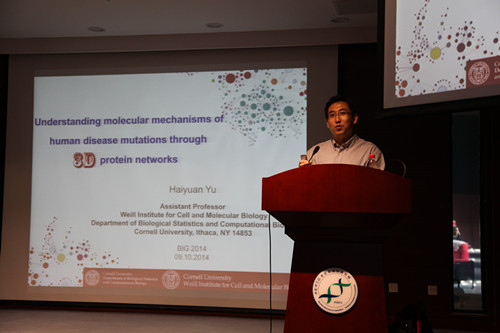When talking about the protein-protein interaction network, people in life science most likely come up with a map of circles and lines. Circles represent various proteins and the lines connecting them indicate complex interactions within the network, which eventually compose a living organism. Other than showing people the complexity of life, have you thought about how to use such information in practice? September 12th, 2014, Dr. Haiyuan Yu from Cornell University, USA visited Beijing Institute of Genomics (BIG), Chinese Academy of Sciences (CAS) and presented the recent research work in his lab with the title “Understanding molecular mechanisms of human disease mutations through 3D protein networks”. Nowadays, the most popular databases of protein-protein networks are established based on guilt-by association ( i.e., protein products of genes cause the same disease tend to interact) and usually take all potential interactions in the literature, including the output from affinity-purification mass spectrometry (AP/MS), which generates protein-complex information rather than direct interactions. More importantly, these networks ignore the structures of the interacting proteins, thus further reducing their reliability. After an in-depth data mining, Dr. Yu’s lab decided to integrate the protein structure information and the only proved direct protein-protein interaction data, to build two databases: HINT (only quality 2D network) and INstruct (Co-crystal and Homology Models). These databases could be used in examining the structural principles of genetic diseases related mutations and disentangling the complex nature of genotype-to-phenotype relationships. With one example of looking into the interaction of MLH1 and PMS2 (both known to cause colorectal cancer), Dr. Yu further pointed out that the mutations in protein interacting domains may lead to alterations in the original interactions. Nevertheless, the “guilt-by-association” has a much higher possibility to be true when applied to recessive in-frame mutations and truncating mutations than dominant mutations. These complex interactions with higher resolution provided by HINT and INstruct, would help to clarify the molecular mechanisms of genetic diseases. Besides the above presented research in network pathology, Dr. Yu’s lab also put essential efforts in network evolution, including the study of functional and comparative genomics, molecular and dynamic proteomics, as well as algorithms and tools development. So far, he has published more than 50 peer-reviewed papers and served as an assistant professor in Cornell University since 2010 (more details are available in http://yulab.icmb.cornell.edu/index.shtml). Dr. Haiyuan Yu was invited by Outstanding Scientists Forum program of the journal Genomics, Proteomics and Bioinformatics (GPB). GPB is a peer-reviewed journal that publishes papers from all over the world in the fields of omics and bioinformatics. Founded in 2003, GPB is the official journal of Genetics Society of China and Beijing Institute of Genomics, CAS. Currently, GPB is an Open Access journal hosted by Elsevier. So far, it has been indexed by PubMed/Medline, PubMed Central, BIOSIS Previews, Scopus, etc. In 2013, GPB was awarded a grant from the Program for Improving International Impact of STM Journals of China. GPB aim to serve as a premier platform for communication among scientists in omics and bioinformatics field, and enhance collaborations among scientific communities. More details about the journal can be found at http://www.journals.elsevier.com/genomics-proteomics-and-bioinformatics. If you’re interested in giving talks in CAS and exploring opportunities of collaboration with the top biological and bioinformatics scientists in China, please feel free to contact GPB editorial office (editor@big.ac.cn). For students and faculty members who are interested in inviting top scientists around the world to BIG, GPB would also welcome your suggestions and help. Dr.Haiyuan Yu was giving a talk (Image by GPB) 
